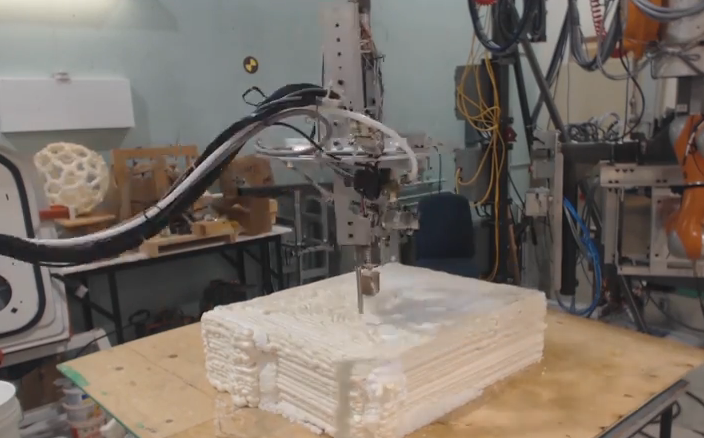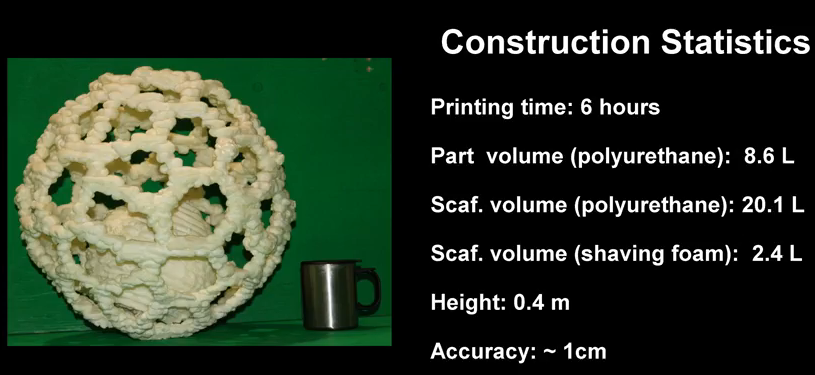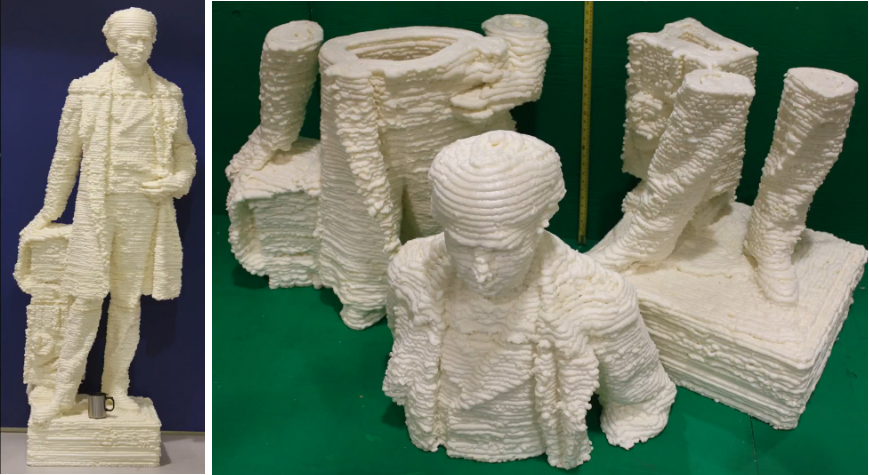Researchers 3D Print 7-Foot-Tall Statue of Sir Wilfrid Laurier Out of Polyurethane Foam & Shaving Cream
Over the year and a half since we’ve launched 3DPrint.com I have seen some pretty innovative approaches taken within the 3D printing industry. From pancake printers to printing objects that are invisible to the naked eye, there certainly is no lack of creativity and innovation within the space.
One recent project taken on by Eric Barnett and Clément Gosselin from the Robotics Laboratory, Department of Mechanical Engineering at Laval University in Quebec City, Canada, certainly ranks up there with some of the more creative approaches to 3D printing I have recently seen.
The research, which was supported by a grant from the Social Sciences and Humanities Research Council of Canada (SSHRC), took 3D printing to the next level in terms of scale and scope using foam as the main agent.
“The objective of this project is to create automated robot-driven fabrication technology capable of producing large-scale architectural prototypes,” Barnett explained to 3DPrint.com. “The Principal Investigator for the project is Professor Aaron Sprecher, Director of the Laboratory for Integrated Prototyping and Hybrid Environments (LIPHE) in the School of Architecture at McGill University.”
The team set out to 3D print a large statue of Canada’s 7th Prime Minister, Sir Wilfrid Laurier, not from thermoplastic, clay, or even metal, but out of standard polyurethane foam. Moving things even more outside the box, they didn’t use a typical Cartesian or Delta-based 3D printer, instead opting for a cable-suspended robotic printer.
“The printer workspace is approximately one meter cubed, but could be expanded relatively easily—this is one of the main advantages of using a cable-suspended system,” Barnett told us. “The printer is currently capable of approximately 1 cm resolution, with deposited paths being 1 cm high and 12 mm wide. The construction time depends mainly on the volume, the height, and the detail of the part.”
 To start the project they needed a 3D model to base the print off of. To do this they first scanned an actual statuette of Laurier which they pulled from the university’s museum collection. The statuette consisted of plaster, was produced way back in 1898, and measured 0.725 meters or about 2.37 feet tall. The scanning was performed by the Computer Vision and Systems Laboratory at Laval University, which used a Creaform Go!Scan 3D device. Once scanned they were able to created a 3D model with 1mm resolution and 1,052,706 triangular faces, which was then fed into the computer to provide the necessary instructions for the printer to begin.
To start the project they needed a 3D model to base the print off of. To do this they first scanned an actual statuette of Laurier which they pulled from the university’s museum collection. The statuette consisted of plaster, was produced way back in 1898, and measured 0.725 meters or about 2.37 feet tall. The scanning was performed by the Computer Vision and Systems Laboratory at Laval University, which used a Creaform Go!Scan 3D device. Once scanned they were able to created a 3D model with 1mm resolution and 1,052,706 triangular faces, which was then fed into the computer to provide the necessary instructions for the printer to begin.
Instead of scaling the model down like many projects require, the researchers decided to scale it up by a 3 to 1 ratio, meaning that the final printed statue would be much larger, standing at 2.16 meters or just over 7 feet tall. Because of constraints to the build environment, the team decided to print the statue in three separate pieces.
Seemingly floating in mid-air, attached only to wires and cables, the extruder began fabricating each section using the polyurethane foam as both the print material and the support material. In order to separate and prevent sticking between the foam support material and the actual print, the team used a thin film of shaving cream to separate the two areas. The 3D printer was able to switch between both materials on the fly, streamlining the process automatically.
When all was said and done, the three sections of the statue took approximately 38 hours to print and used a staggering 275 liters (182 liters for the actual statue, 93 liters for support) of polyurethane and about 23 liters of shaving cream. Although layering was apparent, the statue came our remarkable well, with accuracies of approximately 1 cm.
The same researchers used an identical process to print out a Voronoi Sphere over a period of six hours as well, which you can see pictured to the right. As for what their future plans are with this technology, Barnett told us that they want to improve accuracy, robustness and speed, while investigating the feasibility of installing the system at other locations. Additionally they will be looking towards the testing of new materials such as concrete.
Let us know your thoughts on this approach and how it could be used for various applications moving forward. Discuss in the 3D Foam Printer forum thread on 3DPB.com. Check out the video of the entire print process below:
Subscribe to Our Email Newsletter
Stay up-to-date on all the latest news from the 3D printing industry and receive information and offers from third party vendors.
You May Also Like
3D Printing Unpeeled: New Arkema Material for HP, Saddle and Macro MEMS
A new Arkema material for MJF is said to reduce costs per part by up to 25% and have an 85% reusability ratio. HP 3D HR PA 12 S has been...
3D Printing News Briefs, January 20, 2024: FDM, LPBF, Underwater 3D Printer, Racing, & More
We’re starting off with a process certification in today’s 3D Printing News Briefs, and then moving on to research about solute trapping, laser powder bed fusion, and then moving on...
3D Printing Webinar and Event Roundup: December 3, 2023
We’ve got plenty of events and webinars coming up for you this week! Quickparts is having a Manufacturing Roadshow, America Makes is holding a Member Town Hall, Stratafest makes two...
Formnext 2023 Day Three: Slam Dunk
I’m high—high on trade show. I’ve met numerous new faces and reconnected with old friends, creating an absolutely wonderful atmosphere. The excitement is palpable over several emerging developments. The high...
































